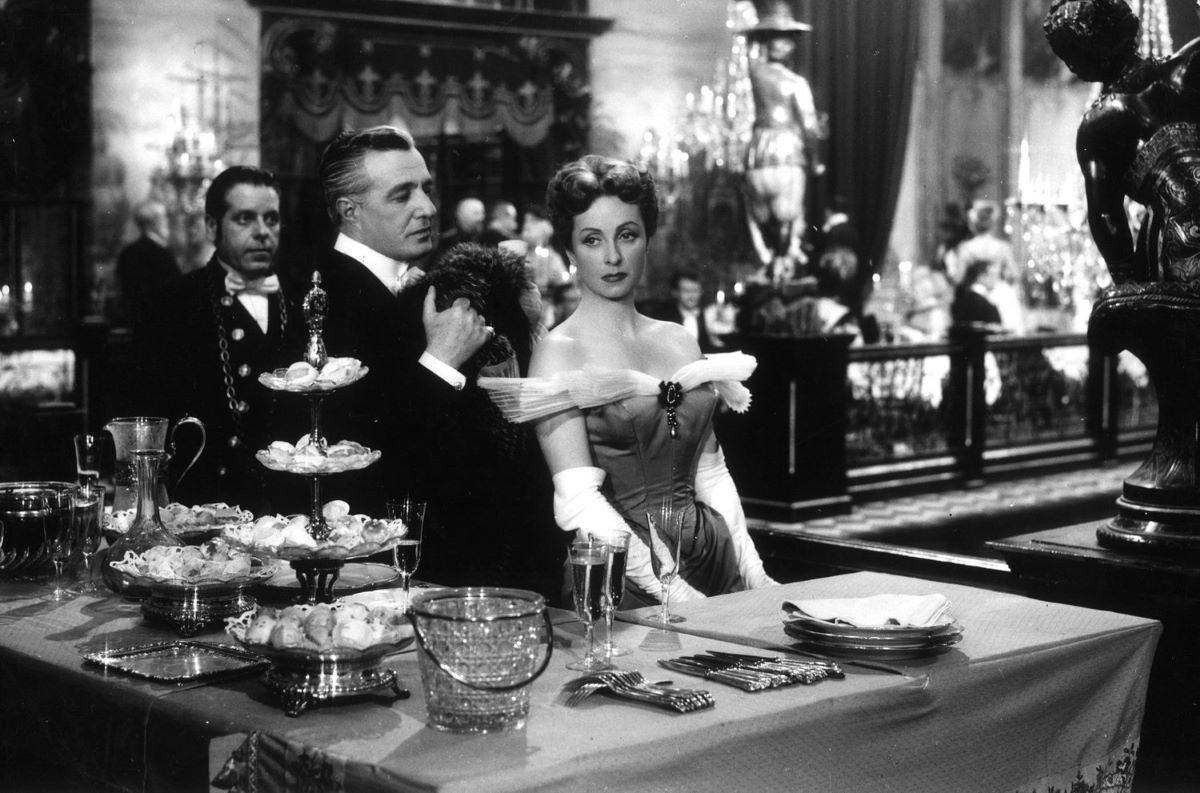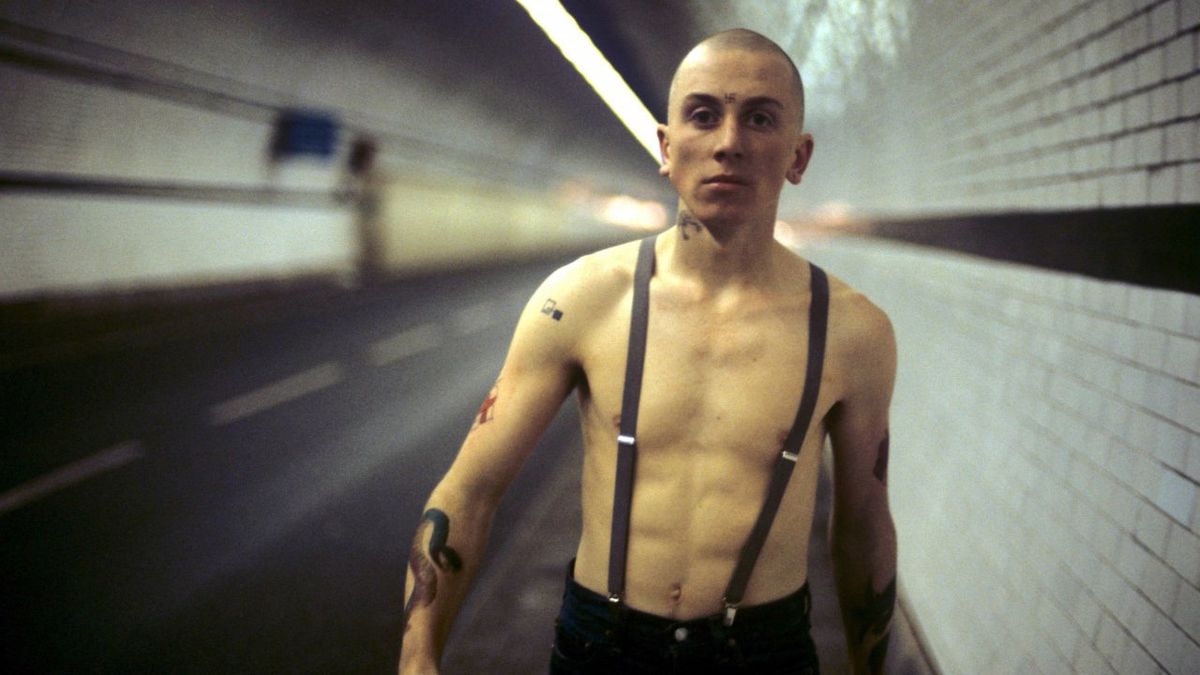The Earrings of Madame de… (1953)
Pauline Kael’s review of The Earrings of Madame de… praises Max Ophuls’s lush, romantic cinematic style, contrasting it with the austere, almost mathematical prose of Louise de Vilmorin’s novella. Ophuls’s fluid camera work and seamless transitions, such as the continuous movement from ball to ball, create a hypnotic and seductive rhythm that envelops the viewer. The performances by Danielle Darrieux, Charles Boyer, and Vittorio De Sica are noted for their impeccable ensemble playing. Kael addresses the criticism Ophuls faced for his focus on elegance and style, arguing that his evocation of a vanished, refined past was essential for exploring the nuances of love. Ophuls’s background, marked by displacement and a struggle to realize his artistic vision during and after World War II, adds depth to his nostalgic and intricate cinematic expression.
* * *
by Pauline Kael
Madame de, a shallow, narcissistic beauty, has no more feeling for her husband than for his gifts: she sells the diamond earrings he gave her rather than confess her extravagance and debts. Later, when she falls in love with Baron Donati, he presents her with the same pair of earrings and they become a token of life itself. Once she has experienced love she cannot live without it: she sacrifices her pride and honor to wear the jewels, she fondles them as if they were parts of her lover’s body. Deprived of the earrings and of the lover, she sickens . . . unto death.
This tragedy of love, which begins in careless flirtation and passes from romance, to passion, to desperation is, ironically, set among an aristocracy that seems too superficial and sophisticated to take love tragically. Yet the passion that develops in this silly, vain, idle society woman not only consumes her but is strong enough to destroy three lives.
The novella and the movie could scarcely be more unlike: the austere, almost mathematical style of Louise de Vilmorin becomes the framework, the logic underneath Ophuls’s lush, romantic treatment. In La Ronde he had used Schnitzler’s plot structure but changed the substance from a cynical view of sex as the plane where all social classes are joined and leveled (venereal disease is transmitted from one couple to another in this wry roundelay) — to a more general treatment of the failures of love. For Ophuls La Ronde became the world itself — a spinning carousel of romance, beauty, desire, passion, experience, regret. Although he uses the passage of the earrings as a plot motif in the same way that Louise de Vilmorin had, he deepens and enlarges the whole conception by the creation of a world in such flux that the earrings themselves become the only stable, recurrent element and they, as they move through many hands, mean something different in each pair of hands, and something fatally different for Madame de because of the different hands they have passed through. It may not be accidental that the film suggests de Maupassant: between La Ronde and The Earrings of Madame de . . . Ophuls had worked (rather unsuccessfully) on three de Maupassant stories which emerged as Le Plaisir.
In these earlier films he had also worked with Danielle Darrieux; perhaps he was helping to develop the exquisite sensibility she brings to Madame de — the finest performance of her career. Her deepening powers as an actress (a development rare among screen actresses, and particularly rare among those who began, as she did, as a little sex kitten) make her seem even more beautiful now than in the memorable Mayerling — almost twenty years earlier — when, too, she had played with Charles Boyer. The performances by Danielle Darrieux, Charles Boyer, and Vittorio De Sica are impeccable — ensemble playing of the smoothness usually said to be achieved only by years of repertory work.
However, seeing the film, audiences are hardly aware of the performances. A novelist may catch us up in his flow of words; Ophuls catches us up in the restless flow of his images — and because he does not use the abrupt cuts of “montage” so much as the moving camera, the gliding rhythm of his films is romantic, seductive, and, at times, almost hypnotic. James Mason once teased Ophuls with the jingle: “A shot that does not call for tracks is agony for poor dear Max.” The virtuosity of his camera technique enables him to present complex, many-layered material so fast that we may be charmed and dazzled by his audacity and hardly aware of how much he is telling us. It is no empty exercise in decor when Madame de and the Baron dance in what appears to be a continuous movement from ball to ball. How much we learn about their luxurious lives, the social forms of their society, and the change in their attitudes toward each other! By the end, they have been caught in the dance; the trappings of romance have become the trap of love.
The director moves so fast that the suggestions, the feelings, must be caught on the wing; Ophuls will not linger, nor will he tell us anything. We may see Madame de as a sort of Anna Karenina in reverse; Anna gets her lover but she finds her life shallow and empty; Madame de’s life has been so shallow and empty she cannot get her lover. She is destroyed, finally, by the fact that women do not have the same sense of honor that men do, nor the same sense of pride. When, out of love for the Baron, she thoughtlessly lies, how could she know that he would take her lies as proof that she did not really love him? What he thinks dishonorable is merely unimportant to her. She places love before honor (what woman does not?) and neither her husband nor her lover can forgive her. She cannot undo the simple mistakes that have ruined her; life rushes by and the camera moves inexorably.
The very beauty of The Earrings of Madame de . . . is often used against it: the sensuous camerawork, the extraordinary romantic atmosphere, the gowns, the balls, the staircases, the chandeliers, the polished, epigrammatic dialogue, the preoccupation with honor are all regarded as evidence of lack of substance. Ophuls’s reputation has suffered from the critics’ disinclination to accept an artist for what he can do — for what he loves — and their effort to castigate him for not being a different type of artist. Style — great personal style — is so rare in moviemaking that critics might be expected to clap their hands when they see it; but, in the modern world, style has become a target, and because Ophuls’s style is linked to lovely ladies in glittering costumes in period decor, socially-minded critics have charged him with being trivial and decadent. Lindsay Anderson, not too surprisingly, found him “uncommitted, unconcerned with profundities” (Anderson’s Every Day Except Christmas is committed all right, but is it really so profund?) and, in his rather condescending review of The Earrings of Madame de . . . in Sight and Sound, he suggested that “a less sophisticated climate might perhaps help; what a pity he is not, after all, coming to make a film in England.” It’s a bit like telling Boucher or Watteau or Fragonard that he should abandon his pink chalk and paint real people in real working-class situations.
The evocation of a vanished elegance — the nostalgic fin de siècle grace of Ophuls’s work — was perhaps a necessary setting for the nuances of love that were his theme. If his characters lived crudely, if their levels of awareness were not so high, their emotions not so refined, they would not be so vulnerable, nor so able to perceive and express their feelings. By removing love from the real world of ugliness and incoherence and vulgarity, Ophuls was able to distill the essences of love. Perhaps he cast this loving look backward to an idealized time when men could concentrate on the refinements of human experience because in his own period such delicate perceptions were as remote as the Greek pursuit of perfection.
Born Max Oppenheimer in Germany in 1902 (he changed his name because of family opposition to his stage career) he worked as an actor and then directed more than 200 plays before he turned to movies in 1930. His first film success, Liebelei, came in 1932; because he was Jewish, his name was removed from the credits. The years that might have been his artistic maturity were, instead, a series of projects that didn’t materialize or, if started, couldn’t be completed. He managed to make a few movies — in Italy, in France, in Holland; he became a French citizen; then, after the fall of France, he went to Switzerland, and from there to the United States, where, after humiliating experiences on such films as Vendetta he made Letter from an Unknown Woman, Caught, and The Reckless Moment. In 1950 in France he finally got back to his own type of material with La Ronde; the flight from Hitler and the chaos of the war had lost him eighteen years. Working feverishly, with a bad heart, he had only a few years left — he died in 1957. No wonder the master of ceremonies of La Ronde says, “J’adore le Passé”; the past of Ophuls’s films is the period just before he was born. There was little in his own lifetime for which he could have been expected to feel nostalgia. Perhaps the darting, swirling, tracking camerawork for which he is famous is an expression of the evanescence of all beauty — it must be swooped down on, followed. It will quickly disappear.
Kulchur, 1961





